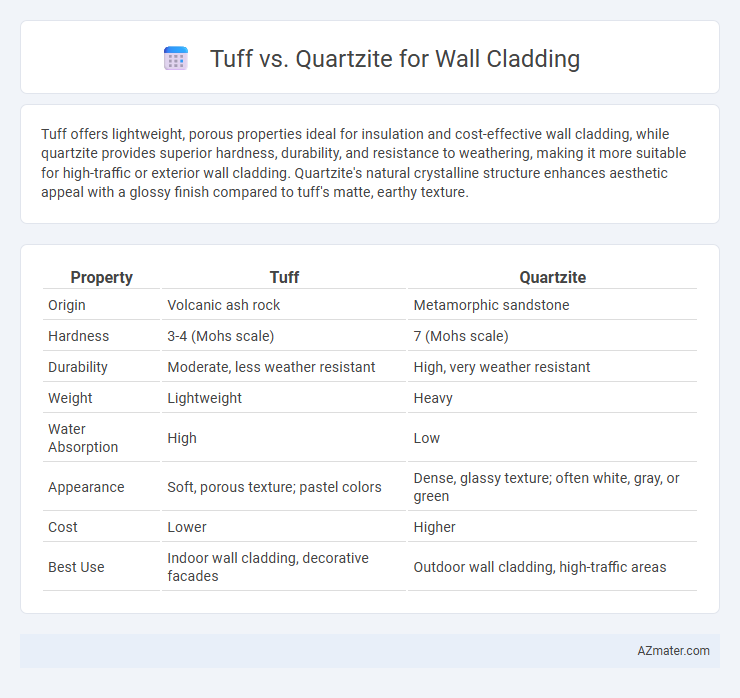Tuff offers lightweight, porous properties ideal for insulation and cost-effective wall cladding, while quartzite provides superior hardness, durability, and resistance to weathering, making it more suitable for high-traffic or exterior wall cladding. Quartzite's natural crystalline structure enhances aesthetic appeal with a glossy finish compared to tuff's matte, earthy texture.
Table of Comparison
| Property | Tuff | Quartzite |
|---|---|---|
| Origin | Volcanic ash rock | Metamorphic sandstone |
| Hardness | 3-4 (Mohs scale) | 7 (Mohs scale) |
| Durability | Moderate, less weather resistant | High, very weather resistant |
| Weight | Lightweight | Heavy |
| Water Absorption | High | Low |
| Appearance | Soft, porous texture; pastel colors | Dense, glassy texture; often white, gray, or green |
| Cost | Lower | Higher |
| Best Use | Indoor wall cladding, decorative facades | Outdoor wall cladding, high-traffic areas |
Introduction to Tuff and Quartzite as Wall Cladding Materials
Tuff, a porous volcanic rock, offers lightweight durability and excellent thermal insulation, making it ideal for wall cladding in both residential and commercial buildings. Quartzite, a metamorphic rock derived from sandstone, provides exceptional hardness, weather resistance, and a naturally attractive appearance, enhancing structural longevity and aesthetic appeal. Both materials suit diverse architectural styles but differ significantly in strength, maintenance requirements, and cost-effectiveness.
Geological Formation: Tuff vs Quartzite
Tuff forms from the consolidation of volcanic ash ejected during explosive volcanic eruptions, resulting in a relatively soft, porous rock that can be easily shaped for wall cladding. Quartzite originates from the metamorphism of sandstone under intense heat and pressure, producing a dense, hard rock with high durability and resistance to weathering. The distinct geological formation processes of tuff and quartzite influence their physical properties and suitability for different architectural applications.
Aesthetic Appeal: Color and Texture Comparison
Tuff wall cladding offers a softer, more porous texture with natural earthy tones ranging from light gray to warm beige, creating a rustic and organic aesthetic. Quartzite provides a harder surface with a glassy sheen and vibrant color variations, including shades of white, green, and pink, lending a sleek, modern elegance to interiors. The choice between tuff and quartzite significantly impacts the overall visual warmth and textural depth, making quartzite ideal for contemporary designs and tuff suited for natural, rugged appearances.
Durability and Strength Analysis
Quartzite offers superior durability and strength for wall cladding due to its high quartz content, which makes it highly resistant to abrasion, weathering, and impact. Tuff, being a volcanic ash-based rock, is softer and more porous, making it less suitable for high-stress applications and more prone to erosion and chipping over time. For projects demanding long-term structural integrity and minimal maintenance, quartzite is the preferred choice, while tuff may be considered for decorative use in low-impact environments.
Weather Resistance and Performance
Quartzite offers superior weather resistance compared to tuff, making it a preferred choice for wall cladding in harsh climates due to its high durability and low porosity. Tuff, a volcanic rock, is more porous and less dense, resulting in lower resistance to moisture and weathering over time. Quartzite's hardness and resistance to erosion ensure long-lasting performance and minimal maintenance for exterior wall cladding applications.
Installation Process and Techniques
Tuff offers easier installation for wall cladding due to its lightweight and softer composition, allowing for simpler cutting and shaping with basic tools. Quartzite, being much harder and denser, requires specialized cutting equipment and precise handling to prevent fractures during installation, often increasing labor time. Both materials benefit from mechanical anchoring techniques, but Tuff allows for faster adhesion with standard mortars, while Quartzite demands high-strength adhesives or mechanical fasteners to ensure durability.
Maintenance and Cleaning Requirements
Tuff requires minimal maintenance due to its porous but relatively soft nature, making it prone to staining if not sealed properly, so periodic sealing is recommended to enhance durability and ease cleaning. Quartzite offers superior resistance to scratches and stains thanks to its dense, non-porous composition, requiring only routine cleaning with mild detergents to maintain its appearance. Both materials benefit from regular dusting and avoiding harsh chemicals; however, quartzite's hardness translates to longer-lasting, low-maintenance wall cladding compared to tuff.
Cost Comparison: Tuff vs Quartzite
Tuff offers a more cost-effective option for wall cladding compared to quartzite, with prices generally ranging from $10 to $30 per square foot, while quartzite typically costs between $40 and $100 per square foot due to its durability and aesthetic appeal. Installation costs for tuff tend to be lower because of its softer texture, which makes cutting and fitting easier, whereas quartzite requires specialized tools, increasing labor expenses. Homeowners seeking budget-friendly yet attractive wall cladding often favor tuff, whereas quartzite suits projects prioritizing long-term investment and premium finishes.
Eco-Friendliness and Sustainability
Tuff is an eco-friendly choice for wall cladding due to its natural formation from volcanic ash, requiring minimal processing and resulting in lower carbon emissions compared to quartzite, which undergoes extensive quarrying and energy-intensive metamorphic processes. Quartzite, while durable and aesthetically appealing, has a higher environmental footprint due to extraction and finishing techniques that consume more energy and generate significant waste. Selecting tuff promotes sustainability by reducing resource depletion and encouraging the use of abundant, locally sourced volcanic materials in construction.
Best Applications and Design Ideas
Tuff offers lightweight, porous characteristics ideal for interior wall cladding where thermal insulation and acoustic dampening are desired, making it perfect for contemporary, natural-looking designs and accent walls. Quartzite's extreme hardness and durability suit exterior cladding and high-traffic areas, providing a sleek, polished finish that enhances modern architectural facades and minimalist design schemes. Combining tuff with quartzite allows for creative contrasts in texture and color, optimizing both aesthetics and performance in residential or commercial wall installations.

Infographic: Tuff vs Quartzite for Wall Cladding
 azmater.com
azmater.com